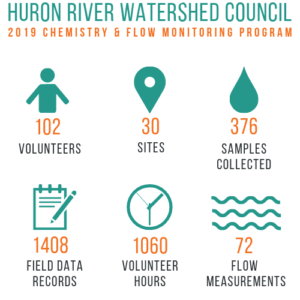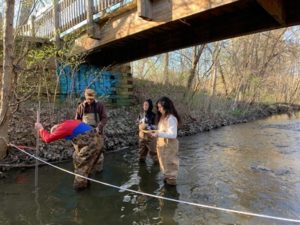
In late September, the Huron River Watershed Council’s Chemistry and Flow Monitoring Program completed its 18th year collecting data on Southeast Michigan waters. This season was the most successful yet, with an unprecedented number of volunteers contributing over a thousand hours. Ramped up recruiting, specifically in the Downriver area, resulted in the participation of over 100 volunteers from five counties.
From April through September, volunteers monitored the waters of 30 sites in Washtenaw and Wayne Counties twice monthly. During site visits, teams of two to four volunteers collected water samples, measured in-stream water chemistry, and recorded flow measurements. Rain or shine volunteers collected essential data and samples from 10 Huron River tributaries, 3 Huron River sites, and 8 Downriver waterways. These data are used by HRWC and its partners to track changes in the condition of local waterways, which informs stormwater management decisions and restoration projects. In the winter months HRWC staff will analyze program results and data to identify pollution hot spots and trends, which will be reported to program partners and volunteers in early 2020.

As part of the program’s 2019 efforts, HRWC and its volunteers conducted routine and storm monitoring at School Girls Glen, a direct drainage to the Huron River located in the Nichols Arboretum on the University of Michigan’s campus. Water chemistry monitoring data will be used to inform future restoration and stream bank stabilization efforts to be implemented at School Girls Glen in 2020.
The Chemistry and Flow Monitoring Program is made possible thanks to funding from two area stormwater management groups, the Middle Huron Partners and the Alliance of Downriver Watersheds. HRWC would also like to acknowledge the Downriver Utility Wastewater Authority and the City of Ann Arbor Water Treatment Plant for their laboratory analysis services. And last but not least, HRWC would like to thank the 102 volunteers who dedicated their time to the program this season. The Chemistry and Flow Monitoring Program would not be possible without you!
For 2019 season data and additional information about the Chemistry and Flow Monitoring Program, click here.



